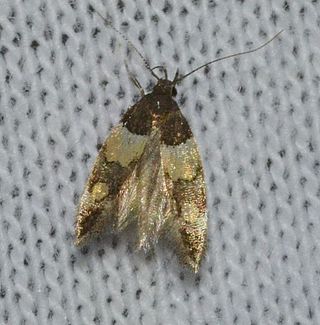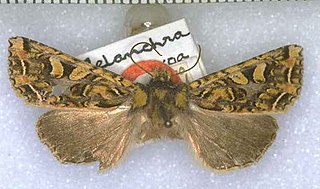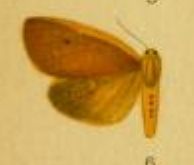
Hasora badra, the common awl, is a butterfly belonging to the family Hesperiidae, which is found in India.

Gomalia elma, also known as the marbled skipper or African marbled skipper, is a species of hesperiid butterfly. It is found in Africa and parts of Asia.

Chliaria othona, the orchid tit, is a species of lycaenid or blue butterfly found in Asia.

Triclonella is a genus of moths in the family Cosmopterigidae.
Episcepsis capysca is a moth of the family Erebidae. It was described by William Schaus in 1910. It is found in Costa Rica.

Meterana tetrachroa is a species of moth of the family Noctuidae. This species is endemic to New Zealand. It is classified as "Data Deficient" by the Department of Conservation.

Spilosoma gynephaea is a moth in the family Erebidae. It was described by George Hampson in 1901. It is found in South Africa and Zimbabwe.
Triclonella pictoria is a moth in the family Cosmopterigidae. It is found in Guyana and Brazil.
Nordstromia humerata is a moth in the family Drepanidae. It was described by Warren in 1896. It is found in north-eastern India.
Microcolona technographa is a moth in the family Elachistidae. It is found in north-eastern India.
Agonopterix sanguinella is a moth in the family Depressariidae. It was described by August Busck in 1902. It is found in North America, where it has been recorded from Arizona, New Mexico and Nevada.
Dactylethrella tetrametra is a moth in the family Gelechiidae. It was described by Edward Meyrick in 1913. It is found in Mpumalanga, South Africa and Réunion.
Brachmia anisopa is a moth in the family Gelechiidae. It was described by Edward Meyrick in 1918. It is found in Colombia.
Dichomeris subdentata is a moth in the family Gelechiidae. It was described by Edward Meyrick in 1922. It is found in Pará, Brazil.
Dichomeris inclusa is a moth in the family Gelechiidae. It was described by Edward Meyrick in 1927. It is found in South Africa.
Hypatima loxosaris is a moth in the family Gelechiidae. It was described by Edward Meyrick in 1918. It is found in Mozambique and KwaZulu-Natal in South Africa.
Hypatima meliptila is a moth in the family Gelechiidae. It was described by Edward Meyrick in 1926. It is found in Papua New Guinea, where it has been recorded from New Ireland.
Anarsia epotias is a moth in the family Gelechiidae. It was described by Edward Meyrick in 1916. It is found in Bengal.
Anarsia sagmatica is a moth in the family Gelechiidae. It was described by Edward Meyrick in 1916. It is found in north-western India.
Moca aphrodora is a species of moth in the family Immidae first described by Edward Meyrick in 1922. It is found in Brazil and Peru.





